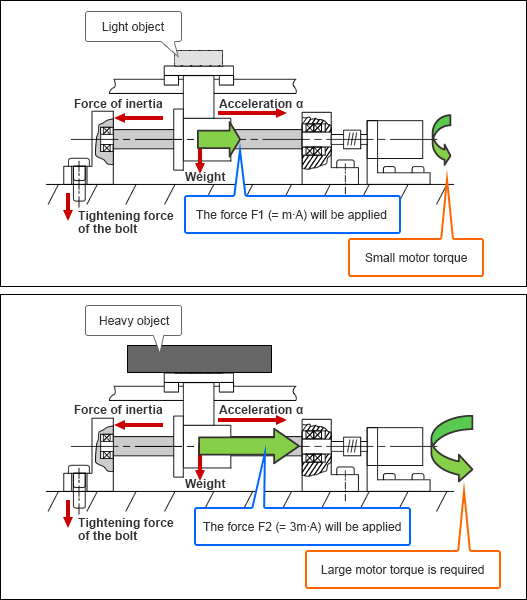#246 Mechanical Engineering and Automation Device Design - 12: Law of Motion - 2
In this volume, we will learn about the second law of motion. You can calculate the moving force required for given conditions of acceleration and mass using this law.
(1) Law of motion
2) The second law of motion
- A force applied to an object (movable body) causes it to accelerate in the direction of the force in proportion to the mass of the object.
- The relationship of force (F) and acceleration (A) can be described as F ∝ A.
- When "m" represents this proportional multiplier, the second law of motion can be expressed as F = m・A. This formula is called "equation of motion".
- The proportional multiplier (m) is the mass of the corresponding object.
- Therefore, reducing the weight of a movable body decreases the required force for moving the body. This means that a smaller motor can be adopted instead.
- The gravitational acceleration g (m/s2) acts on the mass m (Kg). The gravity applied to the object is calculated as W = m・g (N: Newton), which is the weight of the object.
- Depending on the load weight transported on the movable table, the required capacity of a rotary motor varies in order to generate the same acceleration in the linear drive mechanism.
- When the load mass in the left figure is m, the load mass in the right figure is three times more than m (= 3m), the driving force on the right needs to be three times more than the left mechanism in order to generate the same acceleration.

- Therefore, the weight reduction technique is required as an important technique for designing high-speed drive mechanisms.

- Positioning technology
- Designing and processing
- Sensor Technology
- Automation elements technology
- Clean room technology
- Design hints
- Design tips
- Designing and Machining
- Drive mechanism design
- Hints on designing
- Linear Motion Components
- Locating Technology
- Manufacturing technology
- Motion mechanism design
- Pneumatic Drives
- Production Technology
- Technology Outlook
- General description
- Low-cost automation and materials
- Transfer LCA
- #333 Know-how on automation: Pressurized heating technology - 5: Multilayer pressurized heating process technique
- #332 Know-how on automation: Pressurized heating technology - 4: Points to remember when designing mechanism of pneumatic pressurization method
- #331 Know-how on automation: Pressurized heating technology - 3: Pneumatic pressurization method and pressure profile
- #330 Know-how on automation: Pressurized heating technology - 2: Pressurization method and pressure profile
- #329 Know-how on automation: Pressurized heating technology



